Backend Essentials
(fundamentals)
Module 0
Git, CI/CD, branching models
Material drawn from here.
Module 1
Material draw from Databasing.
Module 2
Full-stack architecture
Client-server model
Server-side rendering (e.g. django) vs. a more decoupled architecture
Common architectures
Less common architectures, but important
Cloud providers: e.g. AWS/Azure/Google Cloud vs. DigitalOcean vs. Heroku vs. the tower/desktop cluster in your house
Module 3
Starting to implement (and host) A restful server
Server-side rendering (e.g. django) vs. a decoupled architecture
On localhost (e.g. using express.js or gin or FastAPI)
For mobile devs: Xcode scheme > Test > Pre-actions & Post-actions
In the cloud:
Serverless: AWS Gateway + AWS Lambda
Self managed
Module 4
Mocking the backend
Importance:
Parallelizing development
Troubleshooting
Automated testing (e.g. to guard against regressions)
Techniques:
The above.
AWS S3 (for ready-only API with all GETs)
Compare with in-process mocks (e.g. written in Swift or Kotlin) that are part of your test target.
Relevant distinctions:
Integration tests: narrow vs. broad, e2e vs. not. (Integration tests are not unit tests.)
Module 5
Persistence
Object storage:
Why not store images as blobs? (Mobile devs: why not store an image in CoreData?)
Why isn’t S3 a database? It is a key-value store, but it does have S3 SELECT after all.
ORMs, database tables, primary keys and indexing. (Mobile devs: keep in mind that CoreData uses SQLite, which is a relational database SDK; also, why isn’t CoreData an ORM?)
Association tables, foreign keys, composite keys
Relational databases (e.g. Supabase/PostgresSQL) vs. document “NoSQL” stores (e.g. MongoDB) vs. flat-file databases
Distributed databases (e.g. DynamoDB) and single-table design
Module 6
Abstracting the backend
Service-Level Agreement (SLA)
Mobile devs: The BFF pattern and what to do when you do not have a BFF?
When POST returns 200 instead of 201
Pagination
Long-running jobs. (202 http status code.) Could stream instead?
An API as (a) an abstraction and (b) a contract
{ REST, JSON, and Swagger } vs. { gRPC, protocol buffers, and the protoc compiler and protoc plugins }
http/1.1, http/2, http/3. TCP vs. UDP.
Dependency Inversion Principle in SOLID. (Not IoC with callbacks, but the use of abstract interfaces.)
Module 7
Docker
Why containerize and what’s orchestration? Why isn’t a virtual machine enough or, at the other extreme, a virtual environment (e.g. venv for python)?
Why don’t we use Docker for iOS development?
AWS Fargate vs. Kubernetes
Four exercise combinations using the server-client model:
Server and client in the same Docker container
Server in Docker container, client on host
Server on host, client in Docker container
Server in Docker container, client in another Docker container 🤯
Module 8
Scaling, routing, security
Scaling for traffic
Autoscaling and load balancing
Decoupling microservices using a queue instead
Orchestration (and why it can be more efficient than a cluster of VMs/EC2s)
Routing policies (e.g. geopolitical vs. shortest path)
Caching and CDNs
IaC. (Mobile devs: remember how SwiftUI is supposed to be declarative? A Terraform vs. CloudFormation example?)
Firewalls and VPNs
STUN & TURN in VoIP
Common patterns
Pub-sub
(What if you want to have clients not only subscribe but also publish and then have that propagate to other clients via subscriptions?)
Map-reduce
(Mobile devs: compare with map-reduce syntax in Swift; similarly in other languages.)
Backend for Frontend (BFF)
Module 9
Module 10
Connecting data-science pipelines to production
Kibana and Elastic Search
Snowflake
S3
Jupyter

